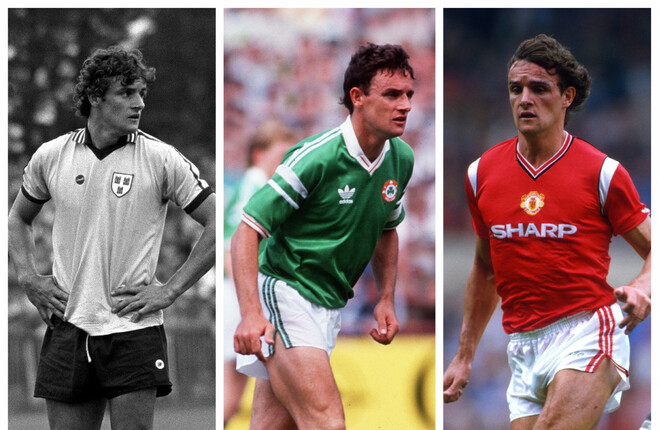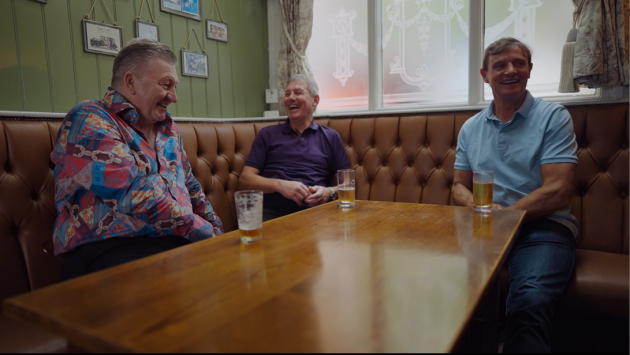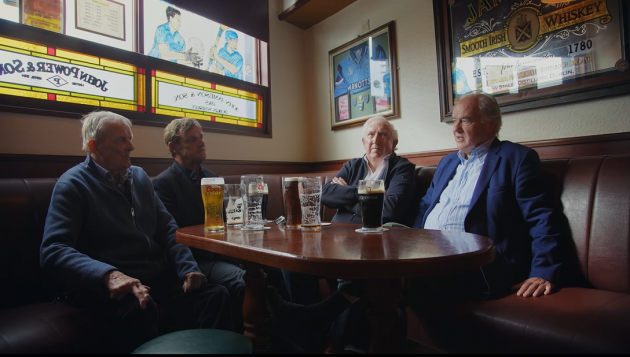KEVIN MORAN’S SPORTING life is one that could no longer be lived.
That much becomes clear within the first 30 seconds of a documentary set to air on RTE One at 9.35pm tomorrow night.
The latest film from director Kevin Brannigan (Kerr’s Kids, In League with Gaddafi), Codebreaker delivers instantly recognisable scenes of nostalgia married with moments of far deeper emotion.
Combined, you are drawn in to a story that is etched in history through Dublin GAA, Manchester United, and the most exciting period of the Republic of Ireland international team.
Kevin Heffernan, Alex Ferguson and Jack Charlton are just three managerial protagonists in a tale of unrivalled achievement and, naturally, disappointment.
The film opens with a DART flashing by Croke Park in the modern day, a man looking out the window at a venue that dominates that corner of Dublin.
There is a flashback to his blue No 6 jersey bursting away from three Kerry players after collecting the ball in the middle of the field.
Makes you wonder what’s quicker, the DART or Moran in his pomp?
Before you have time to think of an answer, we are transported back a few decades to a different time in England. Moran is jumping for joy in the red of United celebrating a goal at Old Trafford.
And then.
To Stuttgart.
Euro 88.
Moran in the green of Ireland playing the free kick forward which leads to Ray Houghton putting the ball in the English net.
A crucial reminder of his role in history that may have slipped from memory.
Just one of the reasons why you will find it difficult to take your eyes from the screen for the duration of a documentary you only wish could last another hour – although Norman Whiteside’s shirt on the day he meets Moran and Bryan Robson in the local pub just outside Manchester which they still frequent might have you flicking the switch.
House of Fun by Madness is an apt sound track as they recount their glory days, and struggles, together.
It wasn’t just the tentacles of Moran’s life that had to be controlled to suit television, even a visit to the house of Peter Reid – he of the infamous tackle in the 1985 FA Cup final where Moran become the first player to be sent off in English football’s showpiece – offered a glimpse of a different life.
He had mementoes of his career in a separate room, like the his jersey from the match against Maradona’s Argentina in the [1986] World Cup, but in the room we spoke to him, on the mantle piece there was a photo of his grandfather with Eamon De Valera because he had fought in the 1916 Rising before leaving the country,” Brannigan explains.
But back to that DART journey from the opening scene.
It passes Croker and eventually reaches Lansdowne Road on the other side of the city. Another of “his sporting broadways”, as described in the film, that has changed beyond all recognition.
Moran has too, of course, but only a bit. He’s 67 and, as Brannigan says, “could probably still do a job for a decent club side.”
Whether he meant GAA or Premier League is debatable. What isn’t is that Moran has a spirit that endures. His enthralling story does too.
In that first half a minute Brannigan distils the sheer magnificence of what was to come.
The two All-Irelands with Dublin.
The same number of FA Cups with United – including that controversial sending off and the campaign which followed to ensure he received a medal.
Euro 88 and Italia 90.
There will also be the scenes, memories and feelings of understated beauty that fill you with warmth during the 50 minutes.
Like when Paul McGrath, his face and voice warm yet somehow vulnerable, looks directly into the camera to softly state of his friend and former teammate: “I love him to death, actually, to be honest.”
In the next scene Moran is queuing at a turnstile outside Old Trafford with his son James, who he greets with a hug. Their season tickets are beside each other in the Alex Ferguson Stand – the man who released him from the club in 1988. Thirty five years on there is no hint of bitterness.
“Football is a constant. United will always be there. There is always a game to go to,” Moran says, although his other son Darragh is a Blackburn Rovers fan as a result of his four years there, retiring the season before they won the Premier League in 1995.
“You’re watching and you’re thinking ‘God, so many years ago I was out there’. It gives you a sense of pride that you’ve done that,” Moran adds.
As this film lays out, viewers unaware of his journey will also be left in a sense of disbelief that it was possible.
The man himself says the same.
He was at Croke Park as fan watching Dublin in the All-Ireland finals of 1974 and 75.
“Jaysis, they’re shocking,” he laughs of his memory of the Dubs after the latter defeat.
The following year he was part of the panel. Dublin GAA was entering a “punkish era” and Moran arrived for his first taste of it with a leather jacket and a Honda 50.
By 21 he had two winners’ medals.
The UCD student was also playing soccer for Pegasus and a FAI Cup clash with Dundalk led to legendary United scout Billy Behan arranging a three-day trial.
United manager Dave Sexton then offered a two-and-a-half-year contract.
Moran asked for time to think and, after accepting, had to break the news to his Dublin teammates.
Three of them share the screen with Moran in Kavanagh’s Pub in Marino: Jimmy Keaveney, Sean Doherty and Tony Hanahoe.
The latter recalls the parting warning shot that was laced with black humour. “Don’t be surprised to hear if Billy Behan is found floating down Liffey with a filing cabinet stuck on the back of his neck.”
The amazing tale takes another incredible twist when Moran explains how he continued to play for Dublin without United knowing, before Heffernan and Hanahoe travelled to Manchester to request formal permission for him to play in the 78 All-Ireland final with Kerry.
Soon he would be a United stalwart, the image during the 1983 FA Cup semi-final win over Arsenal of a bloodied Moran collapsing into the referee’s arms before being stretchered from the pitch, but still managing to salute the United fans with a victorious shake of his fists, the perfect illustration of his commitment.
“Fearless,” Whiteside beams.
“Strong as an ox,” Robson adds.
“Nothing would stop him,” Moran’s wife Eleanor declares.
“That’s how icons are made,” United We Stand fanzine editor Andy Mitten says.
This is a film that honours that incredible legacy.





